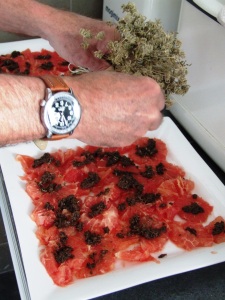We wrapped oysters in the lining of a cow's stomach. We made grapefruit salt. We learned the technique for mastering pate feuilletee inversee (inverted pate feuillettee). We used a nifty gadget that peels, cores and slices an apple, and another that cores a pineapple. We prepared six different recipes, all entitled Millefeuillle (literally "a thousand leaves" but used to mean numerous layers). We used pineapple as a base in five different dishes. And, we ate very, very well.
I've been to three cooking classes with Marie Lecoanet and plan to attend many more. A cook extraordinare, Marie gives cooking lessons in her home in Forcalquier in northern Provence. She recently built an addition on to her home for a new kitchen with plenty of space for cooking classes. She also has a catering business. For anyone who likes to cook, the cooking sessions are fun, informative and delicious as we always eat the meals we prepare.
to attend many more. A cook extraordinare, Marie gives cooking lessons in her home in Forcalquier in northern Provence. She recently built an addition on to her home for a new kitchen with plenty of space for cooking classes. She also has a catering business. For anyone who likes to cook, the cooking sessions are fun, informative and delicious as we always eat the meals we prepare.
The students, between five and ten women and one male (Bernard), all know their way around the kitchen and attack each task with years of chopping and dicing experience behind them. These are serious cooks. No Hamburger Helper or Minute Rice in their pantries. Most are dedicated followers who have been chez Marie numerous times. They know where to find the utensils and pots and pans demanded by the different preparations. They give one another advice. They discuss dishes they have tried at home. They share tips — the best place to buy fish, where to find the dry butter required for the inverted pate preparation, what kind of oil to use when making mayonnaise (peanut — not olive).
Helene was the mayonnaise master during a recent class — patiently adding drops of oil to egg yolks and whisking and whisking after each addition — a tedious procedure. "It's very fragile. You have to be patient…I love it. I love the color," she said as she concentrated on the yellow glob. "She does it with a lot of love," added Marie.
Marie started giving lessons in cuisine about four years ago when her husband retired and the family (she has two teenage children) moved from northeastern France to Provence. In her earlier life, she was a math teacher. She spent 10 years teaching at a French high school in Los Angeles. "I learned from Americans that you can change your profession. Americans do it a lot, but not the French," she says. She speaks with fondness of her years in California. "I admire the enthusiasm and confidence of Americans."
She gave up teaching and started taking cooking lessons. "I always liked to cook," she says, "and I like to eat." She took cooking courses for five years, mastering many of the preparations she now teaches her students. Her cooking is basically French, but she does like to experiment with Asiatic cuisine and other ethnic specialties from time to time. A future course will focus on Cuban recipes.
 Among my favorite dishes is scallops with apples and grapefruit salt — exquisite. The salt is made by blanching grapefruit zest, plunging the zest in cold water, then blanching it again in grapefruit juice, then drying the zest in the oven for 30 to 35 minutes, then mixing it with thyme and salt. It adds a distinctive and delectable flavor, and can be used in many creations.
Among my favorite dishes is scallops with apples and grapefruit salt — exquisite. The salt is made by blanching grapefruit zest, plunging the zest in cold water, then blanching it again in grapefruit juice, then drying the zest in the oven for 30 to 35 minutes, then mixing it with thyme and salt. It adds a distinctive and delectable flavor, and can be used in many creations.
Another winner was one of the millefeuille concoctions, this with smoked duck breast and duck foie gras. Layers of sauteed apples are interspersed with slices of the duck in a ramequin, all doused with calvados then baked for five minutes, and finally topped with a round of spice bread/cake and foie gras. To die for.
The after-cooking meals are a delight, beginning with the de rigueur aperitif (something alcoholic to drink accompanied by goodies we have prepared). Marie's husband Michel joins us and serves the wine during the numerous courses. Now that the weather has warmed, we dine outside on a deck overlooking a picturesque ravine.
While I love eating all these delicacies, and enjoy cooking with others, many of the labor-intensive, multi-step recipes are beyond me — and I am not a bad cook. I am not about to drive to Marseille (1 1/2 hours away) to buy the dry butter required to make the inverted pate dough. And why does it have to be inverted? According to Marie, this procedure involving the butter enveloping the flour instead of the flour enveloping the butter results in a much lighter pastry. Never mind. I'm quite happy with the wonderful millefeuille pastries you can find in any French bakery.
But cooking with Marie is an enjoyable experience and a delicious slice of life in Provence. For more, see Marie's web site: www.lesamisdelucullus.fr

Hi!
I use the cooking book you got me in Reillanne a lot… It’s here with me and I’m gonna use it to prepare something unusual for the Argentinian family we discovered here!
Oh my god, it’s a strange feeling to write and think in English again!!!!!
Have a great year! And be good and moderate during the New Years’s Eve pàrty!!!!!!! :-))
I like your blog!
A big hug from Maedes
LikeLike